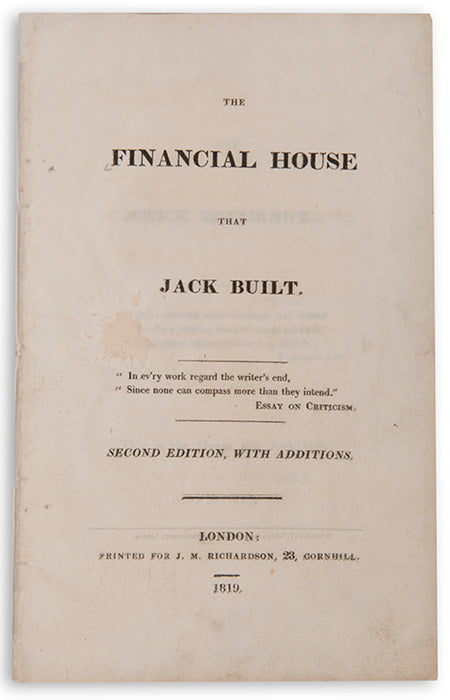
The Financial House that Jack Built.
London, Printed for J.M. Richardson, 1819
'Vansittart came into office at one of the most embarrassing periods in the history of English finance... On 3 March 1813 he brought forward, in a number of resolutions in the House of Commons, a "new plan of finance", dealing with the sinking fund. Under this plan, by repealing portions of the sinking fund bill, 42 George III, c. 71, it was believed the great advantage could be secured of keeping in reserve in time of peace the means of funding a large sum in case of renewed hostilities... This scheme was the first specimen of similar contrivances by Vansittart, all burdened with mysterious complications, which, after first winning from the public a puzzled admiration for the ability of their author, eventually brought him into disrepute' (DNB). His repeated proposals to borrow from the fund led to his eventual undoing in 1823, when he was finally persuaded to exchange the office of Chancellor for a peerage in the House of Lords.
The pamphlet was likely inspired by William Hone's popular tract, The Political House that Jack Built, a seething attack on repression and tightening censorship laws in the wake of the Peterloo Massacre, which appeared the same year with illustrations by George Crucikshank.
Political pamphlet; second edition with additions, same year as the first; 8vo (21.5 x 13.5 cm); paper watermarked 'F 1818', annotations in pen and pencil to p.4 identifying 'The Right Hon. N. V—S—T' as Lord North (pen), and more reliably Nicholas Vansittart (pencil), repaired tears pp.7-8; disbound, recently stitched; [2], 10pp.
Provenance
Delivery
We offer secure and express delivery on all local and international orders of rare books, maps and prints placed through this website.










